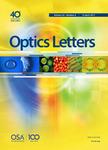版权所有:内蒙古大学图书馆 技术提供:维普资讯• 智图
内蒙古自治区呼和浩特市赛罕区大学西街235号 邮编: 010021

作者机构:Natl Univ Def Technol Coll Comp Sci & Technol Changsha 410073 Peoples R China Acad Mil Sci PLA China Natl Innovat Inst Def Technol Beijing 100071 Peoples R China Natl Univ Def Technol Coll Adv Interdisciplinary Studies Changsha 410073 Peoples R China Natl Univ Def Technol Inst Quantum Sci & Technol Coll Sci Changsha 410073 Peoples R China
出 版 物:《OPTICS LETTERS》 (Opt. Lett.)
年 卷 期:2025年第50卷第2期
页 面:582-585页
核心收录:
学科分类:070207[理学-光学] 07[理学] 08[工学] 0803[工学-光学工程] 0702[理学-物理学]
基 金:National Natural Science Foundation of China
主 题:Machine learning Neural networks Optical computing Optical neural systems Optical signals Silicon modulators
摘 要:Nonlinear activation functions (NAFs) are essential in artificial neural networks, enhancing learning capabilities by capturing complex input-output relationships. However, most NAF implementations rely on additional optoelectronic devices or digital computers, reducing the benefits of optical computing. To address this, we propose what we believe to be the first implementation of a nonlinear modulation process using an electro-optic IQ modulator on a silicon photonic convolution operator chip as a novel NAF. We validated this operator by constructing a convolutional neural network for radio machine learning classification, achieving 92.5% accuracy-an improvement of 27% over the case without a NAF. Compared with optoelectronic systems that rely on separate components, this fully integrated silicon photonic chip allows the NAF to execute nearly synchronously with the convolution operation, significantly lowering latency and reducing the complexity of the peripheral control system. This work paves the way for a large-scale on-chip optical neural network computation. (c) 2025 Optica Publishing Group. All rights, including for text and data mining (TDM), Artificial Intelligence (AI) training, and similar technologies, are reserved.